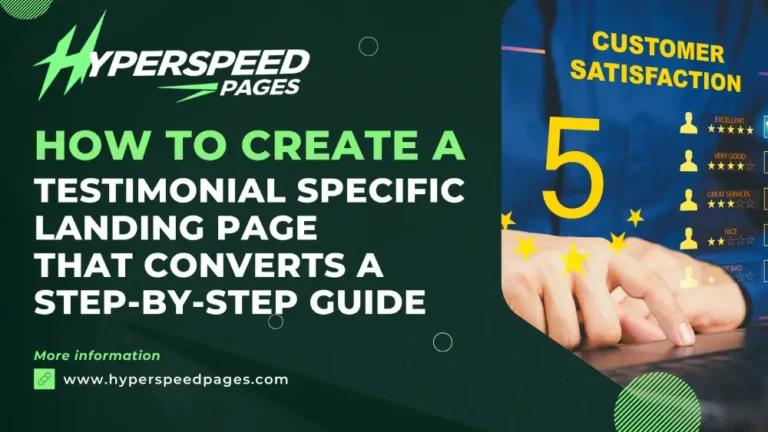
Creating a high-converting landing page is an art and science that requires understanding user psychology, crafting compelling content, and employing technical optimization. A testimonial-specific landing page leverages the power of social proof to build trust and persuade potential customers. Testimonials provide social proof and build trust, offering real-world validation of the benefits your product or service delivers.
Why Focus on Testimonial Landing Pages?
Before we get into the mechanics, let’s first understand the power behind testimonial landing pages.
– Social Proof and Credibility
Customers are more likely to trust recommendations from others than claims made by businesses. Testimonials provide authentic and relatable feedback, making your offering more appealing.
– Increased Trust
Potential customers are more inclined to purchase if they know others have had a positive experience. Testimonials reduce friction in the decision-making process by addressing concerns and objections through the voices of satisfied customers.
– Targeted Messaging
When testimonials align closely with the pain points, desires, or goals of your audience, they help create a focused narrative that resonates with potential buyers.
Now that you understand the importance of testimonials, let’s go over how to craft a landing page that integrates them for maximum effect.
PRO TIP: Here’s how to ace your skills at B2B SaaS Landing Pages
Step 1: Choose the Right Testimonials
The foundation of any testimonial landing page lies in the quality of the testimonials themselves. You need to strategically select testimonials that not only praise your product or service but also address key objections and highlight real benefits that align with your target audience.
– Criteria for High-Quality Testimonials
Specificity Over Generality:
A testimonial that mentions how your product or service solved a specific problem is far more compelling than vague praise. For example, instead of a generic “Great service!”, a more powerful testimonial would say, “After using [your service], our conversion rate increased by 30% within three months!”
Relatability:
Choose testimonials from clients that reflect your target demographic. Prospects should be able to see themselves in the success stories, whether the testimonial comes from a similar-sized business, industry, or persona.
Results-Driven:
Always prioritize testimonials that mention measurable outcomes such as “We saw a 50% increase in productivity,” or “Our sales tripled in the first quarter after signing up.”
Authority Figures:
If possible, use testimonials from thought leaders, experts, or well-known brands in your industry. Endorsements from authoritative sources add credibility and trustworthiness to your landing page.
Visual Elements:
Testimonials accompanied by a high-quality photo or video of the customer tend to perform better. This enhances authenticity and allows potential clients to connect on a personal level.
Step 2: Structuring the Landing Page for Conversions
Once you have selected your best testimonials, the next step is to design the structure of the landing page to maximize conversions. Here’s how you can break it down:
– Above-the-Fold Section: Introduce Value and Build Trust
The area “above the fold” refers to the part of your landing page that is visible before the user scrolls. This is prime real estate and must quickly convey your unique selling proposition (USP) and the core benefit of your product or service.
- Headline: Your headline should be benefit-driven and tightly aligned with your testimonials. For example, “Trusted by [X Number] of Customers Who Boosted Their Sales with Our Solution.”
- Subheadline: Offer a short, concise elaboration on the headline. “Join 1,000+ satisfied customers who’ve seen dramatic results using our platform.”
- Call to Action (CTA): Include a clear and compelling CTA, such as “Start Your Free Trial Now” or “Get a Personalized Demo.”
– Strategic Placement of Testimonials
Sprinkle testimonials strategically throughout the landing page. Ideally, place a powerful, results-focused testimonial right beneath the fold to build trust as the user begins to scroll.
- Testimonial Section Design: Use a dedicated section to showcase your best testimonials. Arrange them with clean formatting and use icons or short titles to indicate the pain point that the testimonial addresses. For example, next to a testimonial about increasing sales, add a dollar-sign icon or a caption like “Increased Revenue by 30%.”
- Variety of Testimonials: Include different formats of testimonials, such as text-based, video testimonials, and even short case studies. Variety adds depth to the social proof.
– Highlight Specific Benefits and Pain Points
As users scroll through your landing page, continue to reinforce the key selling points of your product by linking them directly to your customer testimonials. For instance, if one of your product’s key benefits is time savings, include a testimonial from a client who reduced project turnaround time significantly.
– Include Trust Signals (E-E-A-T)
In line with Google’s E-E-A-T guidelines, your landing page should be filled with trust signals to help establish your brand as authoritative and trustworthy. Here’s how to accomplish this:
- Showcase Credentials: If your company or product has won any industry awards or has been featured in notable publications, add those trust badges to your page.
- Customer Logos: Display the logos of well-known customers who have used your product to further establish credibility.
- Certifications and Reviews: If your product is certified by third-party organizations, showcase those certifications. Integrate customer reviews from trusted review platforms like Trustpilot, G2, or Google Reviews.
Step 3: Optimize for SEO and User Experience
SEO is critical for driving organic traffic to your landing page, but user experience (UX) is equally important. A well-designed page optimized for both can boost your conversion rates dramatically.
– On-Page SEO
- Keyword Optimization: Research and target long-tail keywords related to testimonials and your product or service, such as “best testimonial landing page for SaaS” or “how to use testimonials for higher conversion rates.”
- Meta Tags: Optimize meta title and description to focus on the benefit of testimonials. For example, your meta title could be “How Testimonials Can Skyrocket Your Conversion Rates | [Your Brand].”
- Internal and External Linking: Link to other valuable resources on your website, such as blogs or case studies. You can also link out to authoritative sites that add credibility, such as media outlets where your business is mentioned.
– Page Load Speed
A slow landing page is one of the quickest ways to lose potential leads. Optimize image and video file sizes, minimize JavaScript, and leverage caching to ensure fast page load speeds.
– Mobile Optimization
More users access websites on mobile devices than ever before, so ensure your landing page is fully responsive. Test your testimonial-specific landing page on various devices and screen sizes to confirm that the design remains intact and readable.
Step 4: Include a Strong Call to Action
Your landing page should have multiple calls to action (CTAs) placed strategically throughout the page, but they must all point to the same conversion goal—whether that’s signing up, requesting a demo, or making a purchase.
- CTA Buttons: Use contrasting colors to make CTA buttons stand out and guide the user’s eye toward the action you want them to take.
- CTA Copy: Ensure that your CTA copy reflects the benefit of clicking. For instance, instead of the generic “Submit,” use “Start My Free Trial” or “Get My Customized Plan.”
Step 5: A/B Test for Continuous Improvement
After launching your testimonial landing page, the process doesn’t stop. Regularly perform A/B tests on elements such as:
- Headline variations
- Testimonial placements
- Different CTA text or button colors
- Use of video vs. text testimonials
- Testing helps you fine-tune the page and improve conversion rates over time.
Step 6: Technical SEO Optimization
Technical SEO goes beyond keywords and metadata, ensuring that your testimonial landing page is crawlable, indexable, and offers an excellent user experience.
– Structured Data for Testimonials (Schema Markup)
Structured data allows search engines to understand and display content more effectively. By incorporating structured data, you improve how your testimonials appear in search results, increasing the likelihood of click-throughs.
- Testimonial Schema Markup: Implement review schema or testimonial schema markup on your landing page. This allows Google to display rich snippets, such as star ratings, which can improve your search visibility. For example, you can use this schema to highlight average ratings or specific reviews from customers.
- Rich Snippets for Credibility: Using structured data, you can also encourage Google to display author names, business information, and other relevant details in the search results. This supports the E-E-A-T (Experience, Expertise, Authoritativeness, Trustworthiness) criteria, improving both SEO and user trust.
– URL Structure
- Keyword-Rich, Short URLs: Optimize the URL structure of your landing page. Ensure it’s concise, includes a relevant keyword, and avoids excessive parameters or unnecessary words. For example, a clean URL like yourwebsite.com/testimonials or yourwebsite.com/customer-success is more effective for SEO than yourwebsite.com/page?ID=12345&ref=campaign.
– Page Speed Optimization (Core Web Vitals)
Google’s Core Web Vitals metrics focus on page speed, responsiveness, and visual stability, which are crucial for ranking and user experience. To ensure your landing page ranks high and converts well, you need to meet these performance metrics:
- Largest Contentful Paint (LCP): This measures how long it takes for the largest element (e.g., an image or text block) to load. Ensure all images and videos used in your testimonial section are optimized for faster loading times. You can use tools like PageSpeed Insights to check LCP scores.
- First Input Delay (FID): Make sure your landing page is interactive within milliseconds. A slow FID could be a result of heavy JavaScript, so defer any non-essential scripts until after the page has fully loaded.
- Cumulative Layout Shift (CLS): This measures how visually stable your landing page is during load time. Unstable elements can annoy users and reduce conversions. Ensure that all assets like images and videos have fixed dimensions set in CSS to prevent layout shifts.
Step 7: Data-Driven Design Principles
Design plays a crucial role in how visitors interact with your landing page, and optimizing design using data-driven insights is key to improving conversion rates.
– Heatmaps and Session Recordings
Heatmaps and session recordings provide insights into how users interact with your landing page. By integrating tools like Hotjar, Crazy Egg, or Lucky Orange, you can:
- Identify Pain Points: Discover which sections of the page users focus on, which CTAs they interact with, and where they drop off.
- Optimize Testimonial Placement: Based on user behavior, you can move high-performing testimonials closer to the sections of your landing page that receive the most attention.
– Responsive Design and Device-Specific Optimizations
Responsive design ensures that your landing page adapts smoothly across all devices—desktop, tablet, and mobile. But don’t stop at responsiveness; optimize the experience for specific devices.
- Mobile-First Design: More than 50% of global web traffic is now mobile, so designing for mobile should be a top priority. Optimize mobile layouts by reducing image sizes, using larger touch targets for CTA buttons, and reducing unnecessary scrolling.
- Use Accelerated Mobile Pages (AMP): For faster mobile loading, implement AMP for your testimonial landing pages. AMP pages load nearly instantly on mobile devices, improving SEO and reducing bounce rates.
– Visual Hierarchy and Flow
Create a visual hierarchy that guides visitors through the landing page in a logical, conversion-focused manner. Follow these design principles:
- F-Shaped Pattern: Users typically scan pages in an F-shape pattern. Place key content like testimonials, benefits, and CTAs along the F-shaped path to maximize engagement.
- Use of White Space: Don’t clutter the page with too much content or overwhelming visuals. Use white space to give elements room to breathe, making it easier for visitors to digest information and focus on important details, such as testimonials.
Step 8: A/B Testing for Testimonial Landing Pages
A/B testing allows you to compare two variations of your landing page to see which one performs better. This data-driven approach is key to continuously improving conversion rates. Here’s how to get started:
– Testimonial Format and Placement
- Video vs. Text Testimonials: Test whether video testimonials convert better than text-based ones. While video testimonials often build more trust, they also load slower, so the balance between UX and performance is key.
- Number of Testimonials: Too many testimonials can overwhelm users, while too few might not provide enough social proof. Test different quantities, such as showing three testimonials in a carousel versus displaying six in a grid layout.
– Headline Variations
Test different versions of your headline, one focusing on a specific outcome (e.g., “How [Company X] Increased Sales by 50%”) and another that’s more general (e.g., “See How Our Customers Achieve Success”). Use A/B testing platforms like Google Optimize or Optimizely to conduct tests and monitor conversion data.
– CTA Text and Button Design
Test various CTA texts and button styles to find the most effective combination. Subtle changes like adjusting the color or wording can significantly impact conversions.
- High-Contrast CTA Buttons: Test button colors that stand out from your page background. For example, if your page design uses blue, try using a contrasting color like orange or yellow for your CTA buttons.
- Action-Oriented Text: Instead of a passive “Submit,” test more specific, action-oriented phrases like “Claim My Free Trial,” or “Get Started Now.”
Step 9: Security and Privacy Considerations
Security and privacy signals contribute to building trust on your landing page, which is a critical factor in conversion rates.
– SSL Certificates
Ensure your landing page is served over HTTPS. SSL encryption not only secures user data but also serves as a trust signal. Google prioritizes secure sites in search rankings, and visitors are more likely to engage with a secure site.
– GDPR and Privacy Compliance
With increasing global privacy concerns, make sure your landing page complies with GDPR (General Data Protection Regulation) and other data privacy laws. If you collect user data (e.g., email addresses or names), clearly state your privacy policy and provide an easy-to-find opt-out option.
- Data Collection Transparency: Include a checkbox for users to opt-in to receive future communications, ensuring that you have consent to market to them after their initial visit.
- Cookie Consent: If you’re using tracking cookies, provide a cookie consent pop-up that complies with GDPR and similar regulations.
Step 10: Analytics and Conversion Tracking
Once your landing page is live, it’s crucial to monitor performance using robust analytics tools to continuously optimize conversion rates.
– Set Up Google Analytics Goals
In Google Analytics, set up goals to track key conversion metrics, such as form submissions, button clicks, or demo requests. This helps you measure the effectiveness of your landing page and determine which sections are driving conversions.
– Event Tracking
Use Google Tag Manager to set up event tracking for specific interactions on the page. For instance, track how many users click on different testimonials or play video testimonials. This granular data will help you optimize testimonial placement and format over time.
– Monitor Bounce and Exit Rates
High bounce or exit rates on a landing page suggest friction points or a lack of engagement. Use this data to identify underperforming sections and refine your design, copy, or testimonial strategy.
Putting It All Together
Creating a testimonial-specific landing page that converts isn’t just about slapping a few customer reviews on a webpage. It’s a highly strategic process that involves thoughtful selection of testimonials, data-driven design, SEO optimization, and technical performance improvements.
SOURCE:




